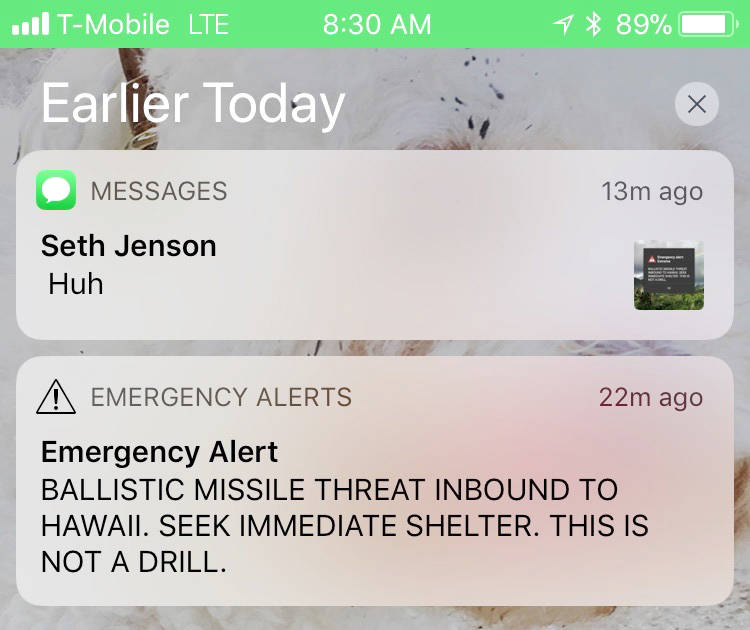Almost a year after a false ballistic missile alert terrified Hawaii, Canada is ”finalizing” a protocol for notifying the public of a genuine airborne threat of mass destruction.
Internal federal government memos and emails obtained through the Access to Information Act show the early-morning Jan. 13 alert that sent people in the tropical U.S. state scurrying for cover soon had Canadian officials scrambling to figure out their own system for informing the public of an incoming missile.
The mistaken Saturday alert from the Hawaii Emergency Management Agency urging people to seek immediate shelter was rescinded 38 minutes later, prompting numerous questions.
In Canada, federal officials had received at least half a dozen media inquiries by midday Monday asking what the government would do in the event of a nuclear missile attack.
READ MORE: Hawaii missile-alert mistake feeds doubts about a real emergency
Officials scheduled a teleconference to “clarify roles and responsibilities” between Public Safety Canada and National Defence and co-ordinate messaging across both departments, the newly released notes say.
Public Safety briefing materials dated Jan. 15 say it was presumed that any early-warning system with respect to a missile launch would rest with Defence and the Canadian Forces, but “this assumption would need to be verified.”
The federal Government Operations Centre, a central emergency-management hub, was “currently engaged in developing a notification protocol” with Defence related to a missile attack, the notes add. The protocol would allow information to be shared with federal agencies as well as provincial and territorial emergency management organizations.
But there was a snag.
Canada’s National Public Alerting System — known as Alert Ready — did not specifically provide for the threat of a potential missile strike, instead focusing on domestic calamities such as floods, fires, severe weather, chemical spills and terrorist incidents. Alerts have been distributed via television and radio broadcasts and, as of recently, through messages to mobile phones.
READ MORE: Did you get the message? Canada tests its emergency alert system
The only federal department connected to the alerting system was Environment and Climate Change Canada, to issue severe-weather alerts.
“ECCC has no mandate to issue an alert related to a potential missile strike,” the documents say.
Public Safety wasn’t even sure if the department could send out a nation-wide alert instantly. Warnings had generally been localized, proceeding from one province to another with the movement of a weather system.
A Canadian alert about a missile strike would likely come from the Prime Minister’s Office, the notes say.
Officials had a better sense of the planned Missile Launch Notification Protocol a few days later, more extensive briefing materials dated Jan. 18 indicate.
Once a missile was in the sky, the Canadian Forces would tell the Government Operations Centre immediately and the centre would, in turn, inform the emergency management community by email if there were no threat.
“If there is a potential or actual threat to Canada or Canadian interests, the (operations centre) will initiate a conference call with the relevant key partners to share information and co-ordinate the appropriate whole-of-government response.”
READ MORE: Hawaii volcano shoots lava into sky; evacuations ordered
Officials saw several problems with having the Government Operations Centre issue a public bulletin through Alert Ready about a missile strike.
There would need to be careful consideration of legal liability and using the centre could create an overlap with established channels, resulting in duplicate messaging “that could potentially add to overall confusion.”
Notes prepared some weeks later flesh out the plan.
In the event of a missile attack, NORAD, which safeguards North American airspace, would inform Defence, which would then notify “appropriate officials.”
“Canadians would then be notified through all available channels, including the media and social media,” the notes say. “Emergency alerts are typically issued by the provincial or territorial emergency management agencies which are responsible for the ‘on-the-ground’ response.”
However, some work remains on the finer points.
Federal agencies are “finalizing details” of the Missile Launch Notification Protocol said Karine Martel, a spokeswoman for Public Safety Canada.
“The details of the protocol will be implemented in due course.”
Jim Bronskill, The Canadian Press



